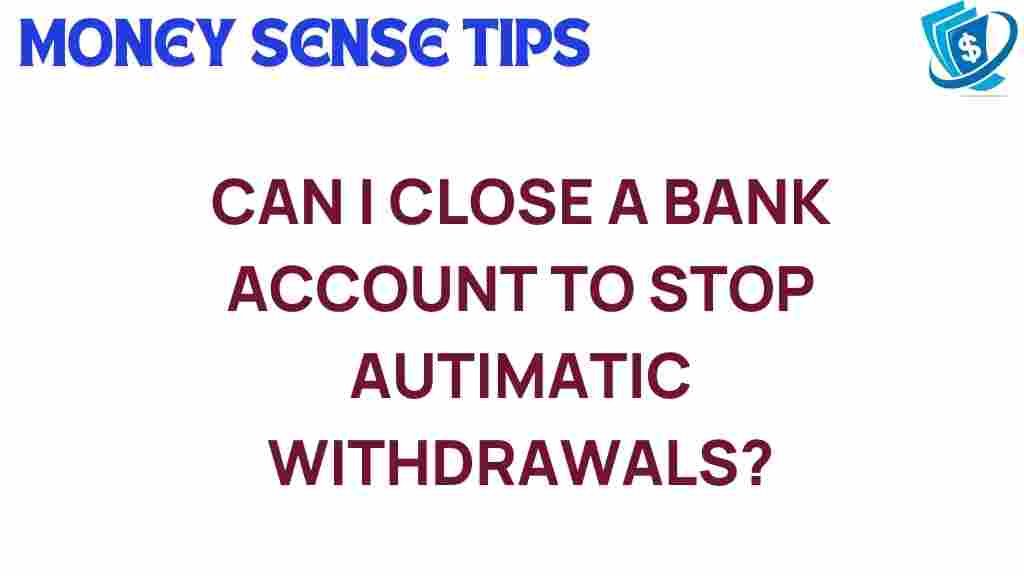Can Closing a Bank Account Halt Automatic Withdrawals?
Managing your finances effectively is crucial for maintaining a stable financial future. One of the aspects of financial management that often comes into play is dealing with automatic withdrawals. If you’re considering closing a bank account, you might wonder: can this action halt automatic withdrawals? In this article, we will explore the ins and outs of account closure and its effect on automatic payments, helping you understand your rights as a consumer and the banking policies that govern these processes.
Understanding Automatic Withdrawals
Automatic withdrawals, also known as direct debits, are transactions that allow companies to withdraw funds directly from your bank account on a scheduled basis. These are commonly used for:
- Monthly subscription services (e.g., streaming services, software subscriptions)
- Utility bills (e.g., electricity, water)
- Loan payments (e.g., mortgage, personal loans)
- Insurance premiums
While automatic withdrawals can simplify your financial management by ensuring that bills are paid on time, they can also pose challenges, especially if you decide to close your bank account.
What Happens When You Close a Bank Account?
When you close a bank account, several things occur:
- The account is no longer active, meaning you cannot make transactions, including deposits or withdrawals.
- Any outstanding checks may bounce, leading to potential fees and penalties.
- Automatic withdrawals linked to the account will generally fail, as the bank will not process transactions from a closed account.
However, it’s essential to understand the nuances involved in stopping payments and managing your financial commitments post-closure.
The Process of Stopping Automatic Withdrawals
To effectively halt automatic withdrawals before or after closing your bank account, follow this step-by-step process:
Step 1: Identify All Automatic Withdrawals
Before closing your bank account, take time to list all automatic payments associated with it. Review bank statements for:
- Recurring payments
- Subscriptions
- Loan repayments
- Insurance payments
Step 2: Contact Service Providers
Once you’ve identified the automatic withdrawals, contact each service provider to inform them of your account closure. Most companies will require you to:
- Provide them with your new bank account details to continue the service.
- Cancel the existing payment method, which might involve filling out a request form.
Step 3: Monitor Your New Account
After you’ve set up your new bank account for automatic withdrawals, monitor it closely for the first few months. Ensure that:
- All automatic withdrawals are processed correctly.
- No payments from the old account are still being attempted.
Step 4: Confirm Account Closure
Once you are confident that all automatic withdrawals have been successfully transferred and no pending transactions remain, you can proceed with closing your bank account. Confirm the closure with your bank, and consider requesting written confirmation for your records.
Potential Issues with Closing a Bank Account
While closing a bank account can effectively halt automatic withdrawals, there are potential issues you may encounter:
- Bounced Payments: If you forget to update a service provider with your new account details, payments may bounce, leading to fees.
- Service Interruptions: Some services may require a short period to process your new payment information, resulting in interruptions.
- Missed Payments: If you do not keep track of your automatic withdrawals, you might accidentally miss a payment, affecting your credit score.
Consumer Rights and Banking Policies
As a consumer, you have rights regarding banking practices, including the process of stopping payments. Familiarizing yourself with these rights can better equip you in managing your financial transactions:
- Right to Cancel: You have the right to cancel automatic withdrawals at any time. Notify your service provider in writing to ensure there is a record of your request.
- Right to Accurate Information: Banks must provide clear information about their policies regarding account closure and the handling of automatic payments.
- Protection Against Unauthorized Withdrawals: If an automatic withdrawal is made without your consent, you may dispute the transaction with your bank.
For more detailed information on consumer rights in banking, you can refer to resources provided by the Consumer Financial Protection Bureau.
Troubleshooting Common Issues
Even with careful planning, issues can still arise when closing a bank account and stopping payments. Here are some common problems and how to troubleshoot them:
Problem 1: Payments Still Being Withdrawn
If you find that payments are still being withdrawn from your closed account:
- Check if you have updated all service providers with your new account information.
- Contact your bank to ensure that the account has been fully closed.
- Reach out to the service provider to cancel any pending transactions.
Problem 2: Fees for Missed Payments
If you incur fees due to missed payments:
- Contact the service provider and explain the situation; they may waive the fee.
- Check with your bank regarding any fees for bounced checks.
Problem 3: Difficulty in Setting Up New Payments
If you face challenges in setting up automatic withdrawals with your new account:
- Ensure that your new account is active and in good standing.
- Verify the payment methods accepted by the service provider.
Conclusion
Closing a bank account can indeed halt automatic withdrawals, but it requires careful planning and communication. Understanding the process of stopping payments, along with your consumer rights, is vital to effective financial management. Always ensure that you follow the necessary steps to update your payment information with service providers and monitor your new account to prevent any disruptions or unexpected fees.
By taking these proactive steps, you can manage your financial commitments confidently and maintain control over your finances. If you ever feel unsure about the banking policies or your rights as a consumer, don’t hesitate to reach out for guidance from your bank or a financial advisor.
This article is in the category Services and created by MoneySenseTips Team

1 thought on “Can Closing a Bank Account Halt Automatic Withdrawals? Discover the Truth”